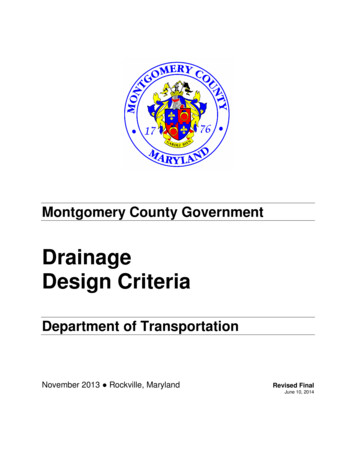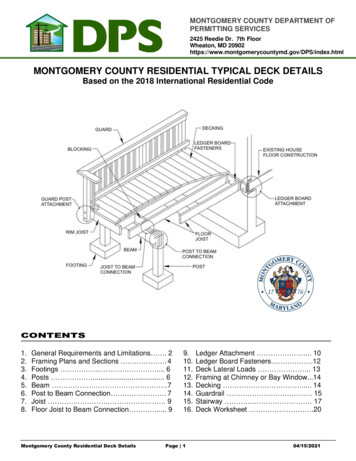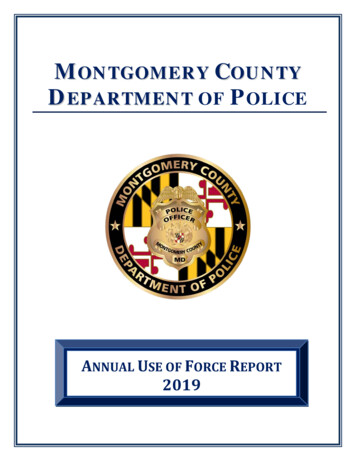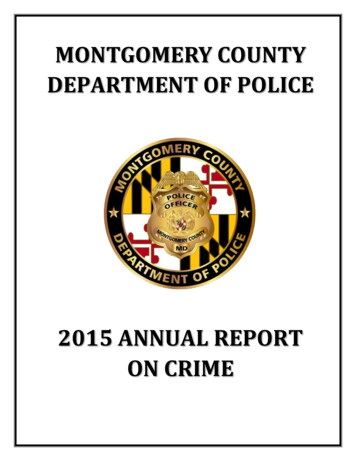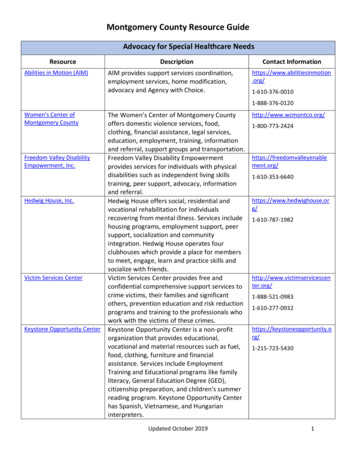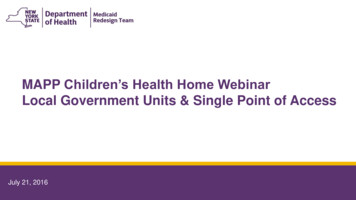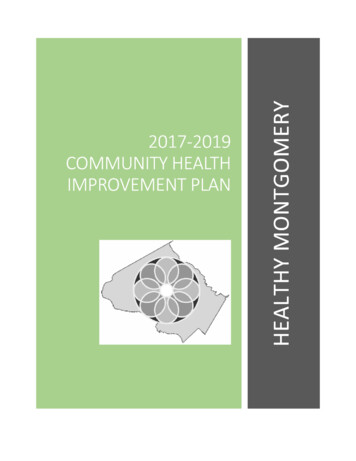
Transcription
AcknowledgementsThe 2017-2019 Community Health Improvement Plan would not have been possible without the leadership ofthe Healthy Montgomery Steering Committee or the expertise and feedback from workgroup participants.Healthy Montgomery Steering CommitteeUma AhluwaliaMarcia AlphonsoJonathan BriceRaymond CrowelBonnie CullisonJackie DeCarlo*Tanya EdelinCarol GarveyLeslie GrahamMichelle HawkinsGeorge Leventhal*Amy LindseyMarilyn Dabady LynkDairy MarroquinKimberley McBrideKathy McCallumBeatrice MillerRachel NewhouseNguyen K. NguyenSamuel OjiCésar PalaciosJoanne RobertsMonique SanfuentesMichael StotoUlder TillmanMyriam TorricoMontgomery County Department of Health and Human ServicesAmerigroupMontgomery County Public SchoolsMontgomery County Department of Health and Human ServicesMaryland House of DelegatesManna Food CenterKaiser PermanenteMontgomery County Collaboration Council for Children, Youth and FamiliesPrimary Care Coalition of Montgomery CountyMontgomery County Commission on HealthMontgomery County CouncilMontgomery County Department of PlanningAdventist HealthCareMedStar Montgomery Medical CenterHoly Cross HealthMental Health Association of Montgomery CountyAfrican American Health ProgramMontgomery ParksAsian American Health InitiativeMontgomery County Department of TransportationLatino Health InitiativeMontgomery County RecreationSuburban Hospital – A Member of Johns HopkinsGeorgetown UniversityMontgomery County Department of Health and Human ServicesMontgomery County Department of Housing and Community Affairs*Healthy Montgomery Steering Committee Co-ChairsHealthy Montgomery Health in All Policies WorkgroupVanessa BriggsAmy Lindsey*Chunfu LiuKara LowingerSonia MoraRachel NewhouseCesar Palacios2 P a g eHoly Cross HealthMontgomery County Department of PlanningMontgomery County Department of Health and Human ServicesMary’s CenterMontgomery County Department of Health and Human ServicesMontgomery ParksLatino Health Initiativewww.healthymontgomery.orgApril 24,2017
Samuel OjiMichael RheinDourakine RosarionKaren ThompkinsMyriam TorricoArlee WallaceMontgomery County Department of TransportationInstitute for Public Health InnovationMontgomery County Department of Health and Human ServicesMontgomery County Department of Health and Human ServicesMontgomery County Department of Housing and Community AffairsMontgomery County Department of Health and Human Services*Workgroup Executive SponsorBehavioral Health Crisis Services Strategic Alignment ParticipantsCarlos AparicioPazit AvivJamie BaltrotskyFernanda BianchiScott BirdsongSara BlackCharlotte BoucherJeff BrackenFrank BrophyEllen BrownDenise Bruskin-GambrellCarolyn CamachoLuis CardonaLidia CarnotaNina ChaiklinPerry ChanCynthia CohenJenny CrawfordRaymond Crowel*Beth Kane DavidsonKaren DuffyAmy FierPeter FlandrauShenita FreemanLarry GambleRebecca GarciaElinor GinzlerSybil Greenhut**Jennifer GrinnellCari Guthrie-ChoDelmonica HawkinsKarla HoffmanMichael Ito3 P a g eCity of RockvilleMontgomery County Department of Health and Human ServicesMontgomery County Fire and Rescue ServicesMontgomery County Department of Health and Human ServicesFamily Services, Inc.Montgomery County Department of Health and Human ServicesMontgomery County Public SchoolsCornerstone MontgomeryMontgomery County Department of Correction and RehabilitationMontgomery County Department of Health and Human ServicesMontgomery County Department of Health and Human ServicesIdentity Inc.Montgomery County Department of Health and Human ServicesAdventist Behavioral HealthMontgomery County Department of Health and Human ServicesMontgomery County Department of Health and Human ServicesMedstar MontgomeryCommunity Clinic, Inc. Health & Wellness ServicesMontgomery County Department of Health and Human ServicesSuburban Hospital – A member of Johns HopkinsEveryMind (Mental Health Association of Montgomery County)EveryMind (Mental Health Association of Montgomery County)Montgomery County Department of Health and Human ServicesWellness and Independence for Seniors at Home (WISH)Montgomery County Department of Health and Human ServicesMontgomery County Department of Health and Human ServicesJewish Council for the AgingMontgomery County Department of Health and Human ServicesEveryMind (Mental Health Association of Montgomery County)Cornerstone MontgomeryMaryland Department of Juvenile ServicesFamily Services Inc.Maryland Department of Juvenile Serviceswww.healthymontgomery.orgApril 24,2017
Jennifer JonesMary Jane JosephApril KaplanLaSonya KellyDeat LaCour***Tina Purser LangleyRachel Larkin**Shawn LattanzioMeng LeeKara LowingerMonica MartinSteve MathisCatherine McAlpineKandy McFarlandLinda McMillanMichael MensahStephanie MooreSonia MoraRegina Morales**Gene Morris**Athena MorrowAna NelsonMarisol OrtizClara ParkJennifer PaukJoseph PetrizzoKara PokrasPaula PuglisiElizabeth RathboneStephanie RosenRich SchiffaueTammy SchmidtCelia SerkinSusie Sinclair-SmithLaurie SlavitBen Stevenson IIGabriel Sussman,Angela TalleyStephanie Svec**Revathi VikramJenny Vidas*Arlee WallaceMario WawrzusinSusan WebbJessica WertheimElijah Wheeler4 P a g eMontgomery County Public SchoolsPrimary Care Coalition of Montgomery CountyCollaboration Council for Children, Youth, and FamiliesMontgomery County Department of Health and Human ServicesIndustrial Organizational PsychologistMontgomery County Department of Health and Human ServicesEveryMind (Mental Health Association of Montgomery County)Montgomery County Department of Health and Human ServicesMontgomery County Department of Health and Human ServicesMary’s CenterMontgomery County Department of Health and Human ServicesPeer Wellness and Recovery Services, Inc.Montgomery County Department of Health and Human ServicesMontgomery General HospitalMontgomery County CouncilMontgomery County Department of Health and Human ServicesMontgomery County Department of Health and Human ServicesMontgomery County Department of Health and Human ServicesMontgomery County Department of Health and Human ServicesMontgomery County Department of Health and Human ServicesMontgomery County Department of Correction and RehabilitationAlzheimer’s AssociationPrimary Care Coalition of Montgomery CountyAdventist Behavioral HealthPrimary Care Coalition of Montgomery CountyHoly Cross HealthFamily Services Inc.Montgomery Heroine Action CoalitionMontgomery County Public SchoolsNational Alliance on Mental IllnessMontgomery County Department of Health and Human ServicesEveryMind (Mental Health Association of Montgomery County)Montgomery County Federation of Families for Children’s Mental HealthMontgomery County Coalition for the HomelessMaryland Department of Juvenile ServicesMontgomery County Department of Correction and RehabilitationMaryland Treatment CentersMontgomery County Department of Correction and RehabilitationAffiliated Sante GroupMontgomery County Department of Health and Human ServicesMontgomery County Department of Health and Human ServicesMontgomery County Department of Health and Human ServicesMontgomery County Department of Health and Human ServicesSuburban Hospital – A member of Johns HopkinsPrimary Care Coalition of Montgomery CountyCollaboration Council for Children, Youth, and Familieswww.healthymontgomery.orgApril 24,2017
Joe WilsonKevin Young**Carrie ZilcoskiJewish Social Service AgencyAdventist Behavioral Health ServicesFamily Services Inc.*Strategic Alignment Project Leader**Strategic Alignment Content Lead***Appreciate Inquiry Facilitator and AdvisorHealthy Montgomery Chronic Disease Cluster WorkgroupCombined diet and physical activity promotion programsBruce BakerMichelle BlancPerry ChanSara DemetriouTanya Edelin*Dianne FisherCarol GarveyLeslie GrahamLinda GoldshollGianina HasburnMichelle HawkinsKimberley HinerCharlene HoltPatricia HortonMary JosephTina Purser LangleyAmy LindseyDairy MarroquinGina MaxhamKimberly McBrideKate McGrailSara McKechnieBeatrice MillerRachel NewhouseMarisol OrtizKristi PierSanjana QuasemJoanne RobertsRachel RuffinCristina RuizTonya SafferRebecca SmithStephanie SlowlyT Kia StewartShari TargumUlder Tillman*5 P a g eCommunity Health and Empowerment through Education and ResearchHoly Cross HealthMontgomery County Department of Health and Human ServicesSuburban Hospital - A member of Johns HopkinsKaiser PermanenteMontgomery County Department of Health and Human ServicesMontgomery County Collaboration Council for Children, Youth and FamiliesPrimary Care Coalition of Montgomery CountyMontgomery County Department of Health and Human ServicesMontgomery County Department of Health and Human ServicesMontgomery County Commission on HealthMaryland Department of Health and Mental HygieneMontgomery County Cancer CrusadeNational Association for the Advancement of Colored PeoplePrimary Care Coalition of Montgomery CountyLiving Well with DiabetesMontgomery County Department of PlanningMedStar Montgomery Medical CenterAdventist HealthCareHoly Cross HealthSuburban Hospital - A member of Johns HopkinsHoly Cross HospitalAfrican American Health ProgramMontgomery ParksPrimary Care Coalition of Montgomery CountyMaryland Department of Health and Mental HygieneMontgomery County Department of Health and Human ServicesMontgomery County RecreationMontgomery County Department of Health and Human ServicesMontgomery County Department of Health and Human ServicesMontgomery County Commission on HealthMontgomery County Department of Health and Human ServicesMaryland Department of Health and Mental HygieneMontgomery County Department of Health and Human ServicesPrivate PractitionerMontgomery County Department of Health and Human Serviceswww.healthymontgomery.orgApril 24,2017
*Workgroup Executive SponsorHealthy Montgomery Measurement & Evaluation SubcommitteeEleni AntzoulatosHira ChowdharyTom LewisChunfu LiuKimberly McBrideBeatrice MillerNguyen K. NguyenPatricia RiosMichael Stoto*Dawn Valentine*Suburban Hospital A member of Johns HopkinsMontgomery County Department of Health and Human ServicesPrimary Care Coalition of Montgomery CountyMontgomery County Department of Health and Human ServicesHoly Cross HealthAfrican American Health ProgramAsian American Health InitiativeSuburban Hospital - A member of Johns HopkinsGeorgetown UniversityAfrican American Health Program*Healthy Montgomery Measurement & Evaluation Subcommittee Co-ChairsHealthy Montgomery is supported by:Adventist HealthCareHoly Cross HealthMedStar Montgomery Medical CenterMontgomery County Department of Health and Human ServicesSuburban Hospital - A member of Johns HopkinsThe 2017-2019 Healthy Montgomery Community Health Improvement Plan is dedicated to the memory of Dr.Ulder Tillman. Dr. Tillman began her tenure in Montgomery County in November 2013 as the County HealthOfficer and the Chief of Public Health Services. She was a true public health champion and will be rememberedfor her calm presence, wisdom and enduring spirit.6 P a g ewww.healthymontgomery.orgApril 24,2017
IntroductionHealthy Montgomery is the community health improvement process for Montgomery County,Maryland. It is an ongoing effort that brings together County government agencies, elected officials,the four County hospital systems, minority health initiatives/program, advocacy groups, academicinstitutions, community-based service providers, the health insurance community, and otherstakeholders to achieve optimal health and well-being for all Montgomery County residents.The Healthy Montgomery community health improvement process is a five-stage process: Phase 1: Environmental Scan which includes compiling and review of available quantitative dataand resources;Phase 2: Collection of qualitative data and development of a comprehensive community healthneeds assessment;Phase 3: Setting of health priorities and development of action plans to address identifiedpriorities; andPhase 4: Implementing, monitoring and evaluation; andPhase 5: Pre-planning for the next iteration of the process.2016 Healthy Montgomery Priority-Setting ProcessThe 2016 priority-setting process represents the second cycle of the Healthy Montgomery communityhealth improvement process. The 2016 Community Health Needs Assessment (CHNA) Reportidentified 63 strategies to address the existing Healthy Montgomery priority issues of obesity,behavioral health, diabetes, cardiovascular disease, cancers, and maternal and infant health. Thesestrategies are derived from the key findings of the qualitative data, quantitative data, communityresources, and evidence-based strategies. In addition, the strategies were considered within theframework of Healthy Montgomery’s goals of achieving health equity for all residents; improving accessto health and social services; and enhancing the physical and social environment to support optimalhealth and well-being and reduce unhealthful behaviors.To prepare for the priority-setting retreat, each Healthy Montgomery Steering Committee (HMSC)member was provided a worksheet and a summary of the CHNA report. The HMSC members wereasked to select up to ten strategies they believed should be a priority for Healthy Montgomery’s 20172019 Community Health Improvement Cycle. The HMSC members considered each strategy in light offive collective impact criteria: Addresses demonstrated inequities among specific groupsData/trends can be monitored over time using a shared measurement approachIncludes multiple sectorsInvolves program and system changes (not an individual program/single organization)Demonstrates an alignment with a Healthy Montgomery health outcomeHMSC members also indicated their respective organization’s ability to commit the time and effortneeded to support the action planning and implementation of the selected strategies. This would assist7 P a g ewww.healthymontgomery.orgApril 24,2017
with the action planning efforts that will follow the HMSC’s final priority-setting determinations.Healthy Montgomery staff tallied the results of the priority-setting worksheets. The top ten strategieswere used during the priority-setting retreat.A skilled facilitator guided the HMSC through the priority-setting process during a four-hour retreat.The facilitator divided the process into two stages. The first stage included a group discussion of theten priorities that emerged from the worksheets. The group discussion was guided by the followingquestions: Does the strategy meet the five community impact criteria?Are there particular issues, concerns, and challenges moving forward that will need to beaddressed in relation to the strategy?Is the strategy realistic and achievable in three years? The response to this question wasextremely important as it also addressed collective buy-in and allocation of resources to assureimplementation.During the second stage of the process, the group voted on the top three priorities for HealthyMontgomery to address over the next three years. In making their final decisions, the HMSC wasreminded of the collective impact criteria and the goals of Healthy Montgomery. The group votedusing a “dot method” to identify each member’s top three strategies. The top three strategies thatreceived the most votes and would serve as the 2017 – 2019 priority strategies were: Implement a Health in All Policies ModelDevelop integrated care programs to address behavioral health needs within primary careservicesCombined diet and physical activity promotion programs8 P a g ewww.healthymontgomery.orgApril 24,2017
Healthy Montgomery Priority Strategy: Implement a Health in All Policies ModelOverviewAs part of the 2016 Community Health Needs Assessment, community members identified severalcharacteristics of a healthy community, including: access to healthy foods, safe neighborhoods andplaces for physical activity, affordable housing and transportation, and quality education. Most often,community members did not focus on health care and treatment but on the underlying socialdeterminants of health.Achieving community health improvement requires an intentionally aligned collective response from arange of sectors that will routinely and consistently embed health considerations into their decisionmaking processes. In response, the Healthy Montgomery Steering Committee decided to establish andsustain a Health in All Policies (HiAP) model to improve the underlying factors of health. The modelwill bring together professionals from a range of sectors (e.g., health, transportation, planning, housing,education, recreation, environment, and law enforcement). The Centers for Disease Control andPrevention also identifies HiAP as a way to achieve the National Prevention Strategy and HealthyPeople 2020 goals.1Healthy Montgomery will use the National Association of City and County Health Official’s 7 Strategiesfor Implementing Health in All Policies2 as a framework to launch this effort throughout the County.1Centers for Disease Control and Prevention, Office of the Associate Director for Policy. Health in All Policies. Retrievedfrom l Association of County and City Health Officials (NACCHO). Local Health Department Strategies forImplementing Health in All Policies. (Fact Sheet). December 2014. Retrieved ources/Programs/Community-Health/factsheet hiap dec2014-1.pdf9 P a g ewww.healthymontgomery.orgApril 24,2017
Priority Strategy: Implement a Health in All Policies ModelGoal: Incorporate health into decision-making in various sectors (government, non-profit, private, etc.)throughout Montgomery CountyObjective: Increase cross-sector relationships in Montgomery County to facilitate and support HiAPimplementationKey Actions Identify organizations that are not represented in existing healthcollaborations/coalitions in Montgomery County Engage health system partners, all sectors of Countydepartments, businesses, faith communities, etc. on design andimplementation of HiAP initiativesDesirable Outcomes Multi-sector HiAPworkgroup to support HiAPimplementationObjective: Establish a shared vision of HiAP across sectors throughout Montgomery CountyKey Actions Develop common terms, language and statements regarding HiAPin order to effectively communicate and promote HiAP Increase awareness of the impact of policies on the socialdeterminants of health Create and distribute educational materials and resourcesthrough various communication channelsDesirable Outcomes Shared vision andunderstanding of HiAP HiAP resource libraryObjective: Identify and catalogue organizational (across various sectors) practices and policies that are mostfeasible to be considered for HiAP implementationKey Actions Desirable OutcomesStudy transportation, planning, zoning, (and others) to identifyopportunities to incorporate health benefits and impact analysesinto current policy frameworks.Survey/conduct an assessment of organizations (transportation,zoning, planning, parks, etc.) to identify policies and practicesthat impact health and wellnessPrioritize practices and policies that are most feasible for HiAPimplementation10 P a g ewww.healthymontgomery.org Cross-sector catalogue ofpractices and policies forHiAP implementationApril 24,2017
Healthy Montgomery Priority Strategy: Develop integrated care programs to address behavioralhealth needs within primary care servicesOverviewMontgomery County is facing unprecedented challenges in meeting behavioral health needs of Countyresidents. These challenges were identified in the Healthy Montgomery 2016 Community HealthNeeds Assessment. In the previous year, the Montgomery County Office of Legislative OversightReport on Behavioral Health and the Healthy Montgomery Behavioral Health Task ForceRecommendations acknowledged similar findings.3,4Behavioral health services are provided in partnership with numerous agencies, departments andproviders throughout the county. Although each entity is involved in providing behavioral healthservices, typically has a niche of expertise and a specialized viewpoint, there is often little coherenceor synergy among the many behavioral health services that are offered and provided. In order toaddress increasingly difficult and complex needs, there needs to be a collective understanding of theCounty’s needs and a more coordinated response.Expanding on the work of the Healthy Montgomery Behavioral Task Force, in September 2016, theBehavioral Health and Crisis Services of the Montgomery County Department of Health and HumanServices began to develop a Strategic Alignment Plan. The Strategic Alignment Plan, similar to theBehavioral Task Force Recommendations, were developed from facilitated meetings of communitystakeholders representing the non-profit, private and public sectors of the county. The long-term goalof the Strategic Alignment Plan is to more effectively and efficiently meet behavioral health needsacross the lifespan, from children to adults and senior citizens; and across the full continuum ofbehavioral health services, including: mental health wellness, mental illness prevention, treatment, andrecovery. The immediate goal is to work collectively to create a unifying vision of what behavioralhealth should look like for Montgomery County.The HMSC priority strategy to address behavioral health needs in the County is a continuation of thework of the Healthy Montgomery Behavioral Health Task Force and incorporates the StrategicAlignment Plan of the Behavioral Health and Crisis Services. The action plan presented belowrepresents those components of the Behavioral Health and Crisis Services alignment plan that areimplementable by Healthy Montgomery within the 2017-2019 community health improvement cycle.The two organizations leading this effort are Montgomery County’s Behavioral Health and CrisisServices and Healthy Montgomery.3Healthy Montgomery Behavioral Health Task Force Recommendations. 2014. Retrieved fromwww.healthymontgomery.org4Carrizosa, N., Richards, S. Office of Legislative Oversight (OLO). OLO Report 2015-13. 2015. Behavioral Health inMontgomery County. Retrieved from http://www.montgomerycountymd.gov11 P a g ewww.healthymontgomery.orgApril 24,2017
Priority Strategy: Develop integrated care programs to address behavioral health needs withinprimary care servicesGoal 1: Enhance outreach and communications to educate the public and care providers on social andemotional wellness, and behavioral and mental health services offered in Montgomery county.Objective: Expand Montgomery County’s behavioral health resource and referral efforts.Key Actions Enhance infoMontgomery to include an up-to-date inventoryof behavioral health services available to the public andreferral agencies. Expand knowledge of 311 outreach team of availablebehavioral and mental health services. Train key community members to identify the signs ofdepression, suicide and substance abuse, and link toresources. Utilize web-based technology to increase awareness of socialand emotional wellness, and behavioral and mental healthservices.Desirable Outcomes Current inventory ofbehavioral health servicesaccessible to the public andproviders. Early identification ofbehavioral health andmental health needs.Objective: Remove barriers that cause underutilization of available behavioral health services inMontgomery County.Key Actions Integrate routine screenings for mental health and substanceabuse into primary care, ambulatory, and community basedservices. Promote co-located, community-placed hubs for coordinatedcare delivery, treatment, and prevention and support services Increase access to expanded, routine services for mentalhealth and substance abuse care. Increase health literacy efforts.Desirable Outcomes Early identification ofbehavioral health andmental health needs. Increased referral andtreatment for mentalhealth needs and substanceabuse.Goal 2: Expand opportunities for behavioral health workforce development, continuing education andtraining.Objective: Improve the skills and performance of professionals in behavioral health and primary caresettings to promote early identification of behavioral health needs and access to services.Key Actions Desirable OutcomesProvide training for client-facing staff to improve earlydetection of behavioral health needs across the life span.Educate prescribers on how to recognize, prevent, identifyand treat opioid addiction and overdose.12 P a g ewww.healthymontgomery.org Early identification ofbehavioral health needs.Reduced opioid addictionand overdose.April 24,2017
Improve clinical skills training to address alcohol and drug useamong youth.Facilitate continuing education and training for communityhealth workers and health promoters.Decreased alcohol and druguse among youth.Objective: Increase opportunities for future behavioral health professionals (Workforce Pipeline) throughtraining, skill development, and cross-discipline training.Key Actions Desirable OutcomesPartner with local educational institutions to increaseopportunities for student engagement, training, andrecruitment.Identify opportunities for culturally and linguistically diversegraduate students.Promote clinicians training institute focused on evidencebased recovery and wellness practices for children and youth.Partner with local educational institutions to provide trainingand field experience in cross- disciplinary treatment andservice coordination.13 P a g ewww.healthymontgomery.org Increased collaboration andpartnerships witheducational/traininginstitutions.Increased numbers ofbehavioral healthprofessionals entering theworkforce equipped toaddress the complex needsand diversity of the county.April 24,2017
Priority Strategy: Combined diet and physical activity promotion programsOverviewAs part of the 2016 Community Health Needs Assessment process, it was determined that chronicconditions could be addressed more effectively through combined diet and physical activity promotionprograms. The four Healthy Montgomery priority areas representing chronic conditions are obesity,diabetes, cardiovascular disease and cancers.The HMSC priority strategy to address these chronic health diseases is also a continuation of the workof the Healthy Montgomery Eat Well Be Active Partnership. The Eat Well Be Active Partnership is theobesity workgroup formed from the first community health improvement cycle that began in 2011.The Chronic Disease Cluster Workgroup (CDCW) developed an implementation plan during an inperson, facilitated planning session. The CDCW included participants from various departments,agencies and hospital/health systems within Montgomery County.The focus of this planning session was to address the underlying causes chronic diseases using thehealth equity, collective impact and triple aim frameworks.The objectives and outcome indicators were developed with guidance from the 2016 HealthyMontgomery Community Health Needs Assessment, Healthy People 2020 goals and NACCHO’s HighQuality Community Healthy Improvement Process Guidance and Examples5.5National Association of County & City Health Officials (NACCHO). Examples of High Quality CHAs and CHIPs.Retrieved from HAIP/guidance-and-examples.cfm14 P a g ewww.healthymontgomery.orgApril 24,2017
Priority Strategy: Combined diet and physical activity promotion programs (obesity, diabetes,cardiovascular disease and cancers)Goal 1: Increase awareness about and decrease access barriers to preventive services.Objectives:1) Increase the proportion of persons who have a specific source of ongoing care.2) Improve health literacy, including patient and provider health insurance literacy.3) Increase the number of tools that disseminate quality health information and available services.Key Actions Offer group and 1:1 education to needed preventive serviceso Cultural competencyo Health literacyo Available serviceso Partnerships with community-based organizations,faith communities, etc. Increase dissemination and use of evidence-based, culturallycompetent, health literacy practices and interventions toinclude provider training and education materials andmessaging Develop a tool/toolkit and disseminate in diverse setting andprograms, health and safety information and informationabout health resources and services that is accurate,accessible, and actionable.15 P a g eDesirable Outcomes Increased % of materials atappropriate reading leveland culturally competent Increased % of materialsand messaging written inmajor languages ofcommunity Increased numbers ofproviders trained in healthliteracy and culturalcompetence Increased numbers ofadults with routine checkup Increased numbers ofadults aged 50 withcolorectal screenings Increased numbers ofwomen with Pap Smear in 3years Increased numbers ofadults and children whoreceive age appropriatescreenings and preventivecare Increased numbers ofadults diagnosed andtreated for high bloodpressure Increased numbers ofpersons with primary careproviderswww.healthymontgomery.orgApril 24,2017
Goal 2: Advance combined healthy eating and physical activity promotion programs for communityresidents.Objective: Increase the % of adults and children who meet or exceed the 2015 physical activity guidelinesfor health.Key Actions Establish a partnership with the Alliance for a HealthierGeneration to identify standards to meet/exceed physicalactivity guidelines for children in Montgomery County PublicSchools (MCPS) Expand affordable and accessible physical activity programsfor working adults Expand Move More MontgomeryDesirable Outcomes Increased numbers ofadults engaging inmoderate physical activity Increased studentparticipation in physicalactivity in past weekObjective: Increase the proportion of overweight or obese adults who report a weight loss of 5-7% of bodyweight.Key Actions Develop and distribute an inventory of physical activity,healthy eating, nutrition education, and nutrition coun
2 P a g e w w w . h e a l t h y m o n t g o m e r y . o r g A p r i l 2 4 , 2 0 1 7 Acknowledgements The 2017-2019 Community Health Improvement Plan would not have been possible without the leadership of the Healthy Montgomery Steering Committee o




